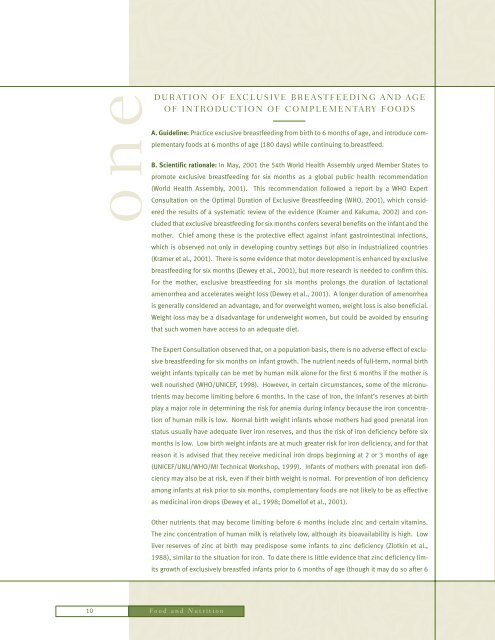Guiding Principles for Complementary Feeding of the Breastfed
Guiding Principles for Complementary Feeding of the Breastfed
Guiding Principles for Complementary Feeding of the Breastfed
Create successful ePaper yourself
Turn your PDF publications into a flip-book with our unique Google optimized e-Paper software.
one<br />
DURATION OF EXCLUSIVE BREASTFEEDING AND AGE<br />
OF INTRODUCTION OF COMPLEMENTARY FOODS<br />
A. Guideline: Practice exclusive breastfeeding from birth to 6 months <strong>of</strong> age, and introduce complementary<br />
foods at 6 months <strong>of</strong> age (180 days) while continuing to breastfeed.<br />
B. Scientific rationale: In May, 2001 <strong>the</strong> 54th World Health Assembly urged Member States to<br />
promote exclusive breastfeeding <strong>for</strong> six months as a global public health recommendation<br />
(World Health Assembly, 2001). This recommendation followed a report by a WHO Expert<br />
Consultation on <strong>the</strong> Optimal Duration <strong>of</strong> Exclusive Breastfeeding (WHO, 2001), which considered<br />
<strong>the</strong> results <strong>of</strong> a systematic review <strong>of</strong> <strong>the</strong> evidence (Kramer and Kakuma, 2002) and concluded<br />
that exclusive breastfeeding <strong>for</strong> six months confers several benefits on <strong>the</strong> infant and <strong>the</strong><br />
mo<strong>the</strong>r. Chief among <strong>the</strong>se is <strong>the</strong> protective effect against infant gastrointestinal infections,<br />
which is observed not only in developing country settings but also in industrialized countries<br />
(Kramer et al., 2001). There is some evidence that motor development is enhanced by exclusive<br />
breastfeeding <strong>for</strong> six months (Dewey et al., 2001), but more research is needed to confirm this.<br />
For <strong>the</strong> mo<strong>the</strong>r, exclusive breastfeeding <strong>for</strong> six months prolongs <strong>the</strong> duration <strong>of</strong> lactational<br />
amenorrhea and accelerates weight loss (Dewey et al., 2001). A longer duration <strong>of</strong> amenorrhea<br />
is generally considered an advantage, and <strong>for</strong> overweight women, weight loss is also beneficial.<br />
Weight loss may be a disadvantage <strong>for</strong> underweight women, but could be avoided by ensuring<br />
that such women have access to an adequate diet.<br />
The Expert Consultation observed that, on a population basis, <strong>the</strong>re is no adverse effect <strong>of</strong> exclusive<br />
breastfeeding <strong>for</strong> six months on infant growth. The nutrient needs <strong>of</strong> full-term, normal birth<br />
weight infants typically can be met by human milk alone <strong>for</strong> <strong>the</strong> first 6 months if <strong>the</strong> mo<strong>the</strong>r is<br />
well nourished (WHO/UNICEF, 1998). However, in certain circumstances, some <strong>of</strong> <strong>the</strong> micronutrients<br />
may become limiting be<strong>for</strong>e 6 months. In <strong>the</strong> case <strong>of</strong> iron, <strong>the</strong> infant’s reserves at birth<br />
play a major role in determining <strong>the</strong> risk <strong>for</strong> anemia during infancy because <strong>the</strong> iron concentration<br />
<strong>of</strong> human milk is low. Normal birth weight infants whose mo<strong>the</strong>rs had good prenatal iron<br />
status usually have adequate liver iron reserves, and thus <strong>the</strong> risk <strong>of</strong> iron deficiency be<strong>for</strong>e six<br />
months is low. Low birth weight infants are at much greater risk <strong>for</strong> iron deficiency, and <strong>for</strong> that<br />
reason it is advised that <strong>the</strong>y receive medicinal iron drops beginning at 2 or 3 months <strong>of</strong> age<br />
(UNICEF/UNU/WHO/MI Technical Workshop, 1999). Infants <strong>of</strong> mo<strong>the</strong>rs with prenatal iron deficiency<br />
may also be at risk, even if <strong>the</strong>ir birth weight is normal. For prevention <strong>of</strong> iron deficiency<br />
among infants at risk prior to six months, complementary foods are not likely to be as effective<br />
as medicinal iron drops (Dewey et al., 1998; Domell<strong>of</strong> et al., 2001).<br />
O<strong>the</strong>r nutrients that may become limiting be<strong>for</strong>e 6 months include zinc and certain vitamins.<br />
The zinc concentration <strong>of</strong> human milk is relatively low, although its bioavailability is high. Low<br />
liver reserves <strong>of</strong> zinc at birth may predispose some infants to zinc deficiency (Zlotkin et al.,<br />
1988), similar to <strong>the</strong> situation <strong>for</strong> iron. To date <strong>the</strong>re is little evidence that zinc deficiency limits<br />
growth <strong>of</strong> exclusively breastfed infants prior to 6 months <strong>of</strong> age (though it may do so after 6<br />
10 Food and Nutrition

















